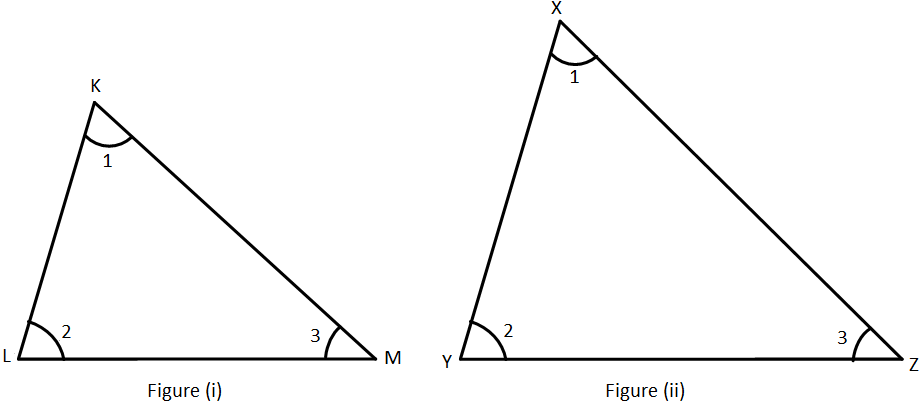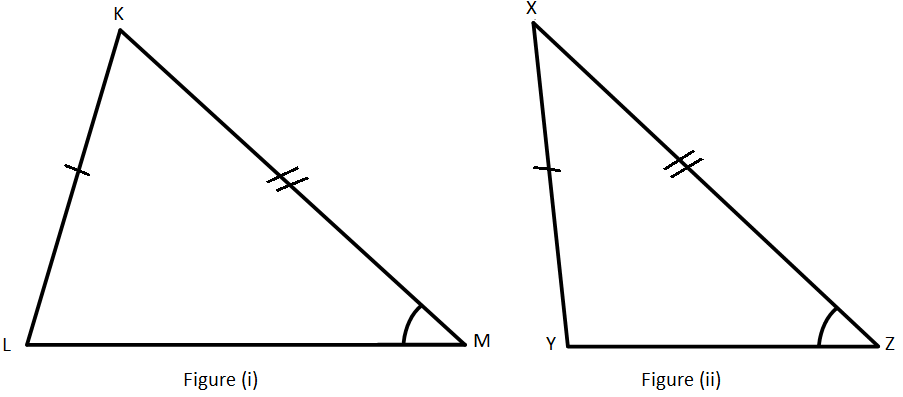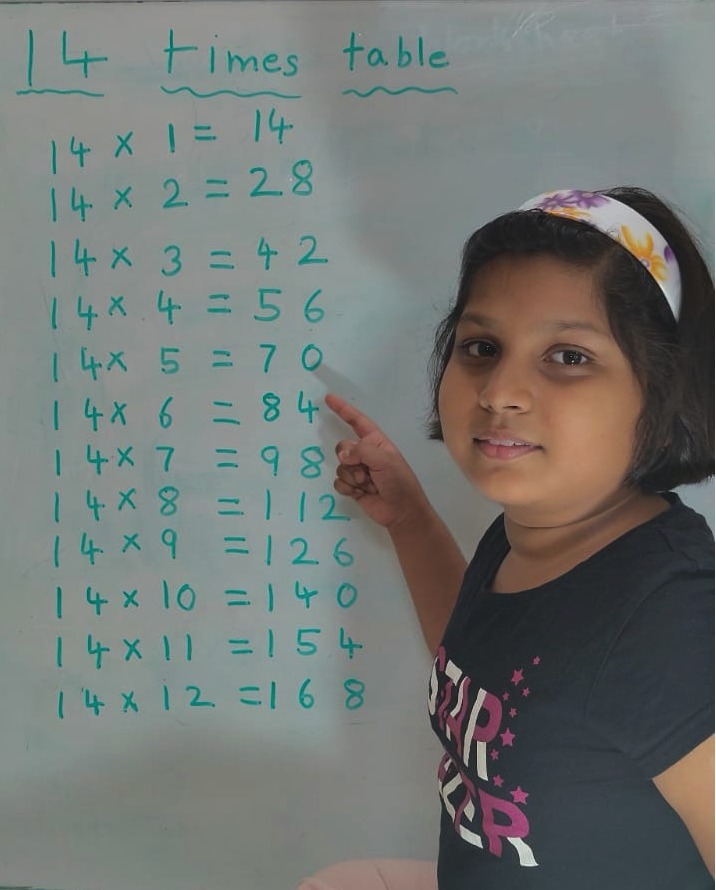Criteria for Congruency
Here we will learn different criteria for congruency of triangles.
I. SAS (Side-Angle-Side) Criterion:
If two triangles have two sides of one equal to two sides of the other, each to each, and the angles included by those sides are equal then the triangles are congruent.
Here in ∆KLM and ∆XYZ,
KL = XY, LM = YZ and ∠L = ∠Y
Therefore, ∆KLM ≅ ∆XYZ.
Note: It is necessary for the included angles to be equal for congruency. If in the above figure, ∠L ≠ ∠Y and ∠L = ∠X, the triangle may not be congruent.
II. AAS (Angle-Angle-Side) Criterion:
If two triangles have two angles of one equal to two angles of the other, each to each, and any side of the one equal to the corresponding side of the other, then the triangles are congruent.
Here in ∆KLM and ∆XYZ,
∠L = ∠Y, ∠M = ∠Z and KM = XZ.
Therefore, ∆KLM ≅ ∆XYZ.
III. SSS (Side-Side-Side) Criterion:
If two triangles have three sides of one equal to three sides of the other, the triangles are congruent.
Here in ∆KLM and ∆XYZ,
KL = XY, LM = YZ and KM = XZ.
Therefore, ∆KLM ≅ ∆XYZ.
IV: RHS (Right Angle-Hypotenuse-Side) Criterion:
If two right-angled triangles have their hypotenuses equal and one side of one equal to one side of the other, the triangles are congruent.
Here, ∠L = ∠Y = 90°, KM = XZ and KL = XY.
Therefore, ∆KLM ≅ ∆XYZ.
Note: * Two triangles will be congruent only if they satisfy any one of the four criterion mentioned above.
** Two triangles may not be congruent if any three parts (elements) of one are equal to the corresponding parts of the other.
Examples:
(i) If two triangles have three angles of one equal to three angles of the other, they are said to be equiangular. But equiangular triangles need not be congruent.
Here, in the given figure, ∆KLM and ∆XYZ are equiangular but not congruent.
In short, if two triangles are congruent, they must be equiangular; but if they are equiangular, they may or may not be congruent.
(ii) If in two triangles, two sides and one angle of one are equal to the corresponding sides and corresponding angle of the other, the triangles need not be congruent.
In the adjoining figure, KL = XY, KM = XZ, ∠M = ∠Z.
But ∆KLM and ∆XYZ are not congruent. For congruency, two sides and the included angle of one must be equal to those of the other.
Note: The abbreviation CPCTC is generally used for ‘Corresponding parts of Congruent Triangles are Congruent’.
From Criteria for Congruency to HOME PAGE
Didn't find what you were looking for? Or want to know more information about Math Only Math. Use this Google Search to find what you need.
Recent Articles
-
Vertical Subtraction | Examples | Word Problems| Video |Column Method
Mar 22, 25 05:20 PM
Vertical subtraction of 1-digit number are done by arranging the numbers column wise i.e., one number under the other number. How to subtract 1-digit number vertically? -
Worksheet on 11 Times Table | Printable Multiplication Table | Video
Mar 22, 25 05:08 PM
Worksheet on 11 times table can be printed out. Homeschoolers can also use these multiplication table sheets to practice at home. -
Worksheet on 10 Times Table | Printable Multiplication Table | Video
Mar 21, 25 03:46 PM
Worksheet on 10 times table can be printed out. Homeschoolers can also use these multiplication table sheets to practice at home. -
5th Grade Prime and Composite Numbers | Definitions | Examples | Math
Mar 21, 25 12:18 AM
5th grade prime and composite numbers -
14 Times Table | Read and Write Multiplication Table of 14| Video
Mar 20, 25 04:03 PM
In 14 times table we will learn how to read and write multiplication table of 14. We read fourteen times table as:One time fourteen is 14 Two times fourteen are 28 Three times fourteen are 42











New! Comments
Have your say about what you just read! Leave me a comment in the box below. Ask a Question or Answer a Question.